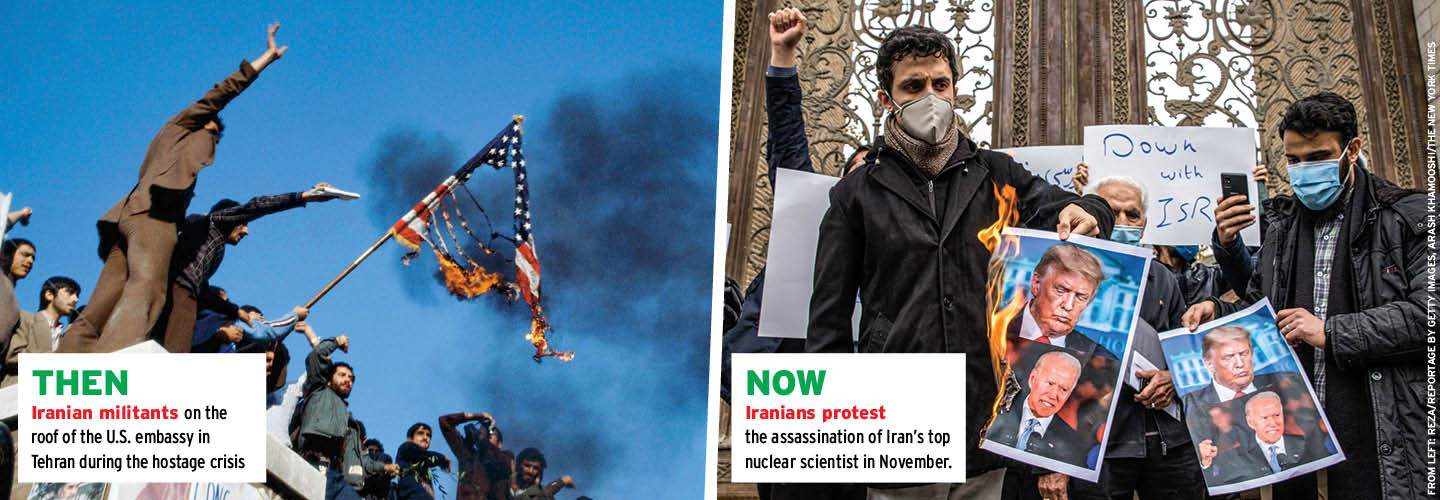For the American diplomats in Iran’s capital of Tehran, the morning started off like any other workday in their volatile corner of the world.
It was November 4, 1979, and there were students outside the U.S. embassy’s walls chanting “Death to America!” But the diplomats had grown accustomed to such demonstrations. Earlier that year, the people of Iran had overthrown that nation’s increasingly unpopular shah (or king), Mohammad Reza Pahlavi, and students were angry at the U.S. for long bolstering the monarch.
Suddenly and swiftly, events spiraled out of the Americans’ control. Dozens of the students scaled the embassy compound’s heavy metal gate while others clambered over the brick walls. Still others split the chains fastening the gate with metal cutters and simply strolled past the Marine guards, who had been instructed to hold their fire.
Following a plan mapped out weeks earlier, the students rounded up the embassy workers, bound and blindfolded them, and paraded them before television news cameras. The Americans would be held hostage, they declared, until the U.S. turned over the shah—who had fled Iran and was receiving medical treatment in New York—for trial.
Thus began one of the most humiliating and consequential episodes in recent American history, a crisis that kept 52 Americans in terrifying, dispiriting, and sometimes physically abusive conditions for 444 days—more than a year and two months. The hostages were finally freed on January 20, 1981—40 years ago.
The Iranian hostage crisis, as it came to be known, has poisoned relations between the U.S. and Iran ever since. Although there have been periodic efforts at engagement, the relationship has been marked by confrontation after confrontation, most recently concerning Iran’s nuclear weapons program.
For the American diplomats in Iran’s capital of Tehran, the morning started off like any other workday.
It was November 4, 1979, and there were students outside the U.S. embassy’s walls chanting “Death to America!” But the diplomats had gotten used to such displays. This corner of the world was unstable. Earlier that year, the people of Iran had overthrown that nation’s increasingly unpopular shah (or king), Mohammad Reza Pahlavi. Students were angry at the U.S. for supporting the monarch.
Suddenly and swiftly, events spiraled out of the Americans’ control. Dozens of the students climbed the embassy compound’s heavy metal gate and over its brick walls. Others split the chains around the gate with metal cutters. Then they simply strolled past the Marine guards, who had been instructed to hold their fire.
The students followed a plan they had mapped out weeks earlier. They rounded up the embassy workers, bound them, and put blindfolds over their eyes. Then they paraded them before television news cameras. The Americans would be held hostage, they declared, until the U.S. turned over the shah. He had fled Iran and was receiving medical treatment in New York, but the students wanted him to stand trial.
Thus began one of the most humiliating and consequential events in recent American history. The crisis lasted for 444 days. For more than a year and two months, 52 Americans were held hostage. They suffered through terrifying, dispiriting, and sometimes physically abusive conditions. On January 20, 1981, the hostages were finally freed. That was 40 years ago.
The Iranian hostage crisis, as it came to be known, has poisoned relations between the U.S. and Iran ever since. There have been periodic efforts at engagement. Even so, the relationship has been marked by confrontation after confrontation. Most recently, the tension worsened over concerns about Iran’s nuclear weapons program.

